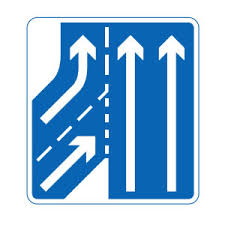1. Using Slip Roads
A major rule of motorway driving is one
that even seasoned motorists can get confused by; when coming down a slip road
to join a motorway, it’s a common misconception that any vehicle in the
left-hand lane must move over into the middle lane to give you the space to
move out safely onto the motorway.
Alas,
it’s actually the other way round; the law states that those on the slip road
must give way to traffic on motorways. That said, most vehicles in the
left-hand lane show common sense and courtesy by pulling into the middle lane
to allow you out.
Long
may the tradition continue as well because for learners, that slip road onto
the motorway can be a daunting experience. To help ease you into the process,
best practise on a dual-carriageway first where the same slip road rule
applies.
2. Using Lanes
Just because there are three lanes doesn’t
mean you can use them any way you want. Instead, you must stay in the left-hand
lane if you’re not overtaking. If you are overtaking, make sure you move back
into the left-hand lane once you’re past the slower-moving vehicle/s.
Remember,
if you end up absentmindedly sitting in the middle lane, you can be done by the
police, fined £100 and given three insurance premium-swelling points on your
licence. And fair enough – after all, hogging the middle lane can cause
congestion plus can create a hazard as other vehicles over- or undertake you in
frustration.
And talking
of undertaking, don’t do it; you must always pass on the right-hand side of a
vehicle. The exception? If there is traffic on the motorway causing congestion,
it can lead to the left-hand lane naturally moving more quickly than the
traffic in other lanes – so it’s okay to follow its flow.
3.
Using common sense
Because
you will typically be driving at 70mph (unless on the M25 or M6 where the
average speed feels more like 15mph…), you will need to ensure you leave enough
space between your car and the vehicle ahead. It means if something should
happen, you will have the time needed to react.
The
basic rule of thumb? Use a marker at the side of the motorway (such as a sign,
tree or bush) and count two seconds once the vehicle in front has passed it; if
you pass the marker on two seconds, you’re in the sweet spot. If you pass it in
under two seconds, you need to back off. If the roads are wet, ensure you
double the second count and in icy conditions, triple it.
4. Using Hard Shoulders
No, these are not designated emergency pee
stops, no matter what your bladder might tell you; hard shoulders are there to
be used in emergencies only such as when your car breaks down.
If you
do need to use one, pull up on to it as far as possible on the left with the
wheels turned left too. Put on your hazard lights immediately and don’t turn
off your sidelights if it’s dark or if there’s fog; other motorists must
still be able to see you.
Finally,
try and get out of the car on the side that is furthest away from the motorway
before waiting behind the barrier where possible. Then call your breakdown
service provider or alternatively, use one of the emergency phones that can be
found at regular points along the hard shoulder.
5.
Using Smart Motorways
If
dealing with a regular motorway wasn’t confounding enough, there are also Smart
Motorways springing up the length and breath of Britain. The same basic
motorway rules apply but with added challenges including being allowed to drive
on the hard shoulder (under
certain conditions), red ‘X’ lanes and emergency refuge areas.






No comments:
Post a Comment